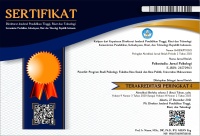The Relationships Between Self-Discipline and Peer-Groups With Smoking Behavior in High School Students
Abstract
One form of negative human behaviour is smoking behaviour. According to re-searchers, two (2) factors influence smoking behavior: self-discipline and peer groups with smoking behaviour. The purpose of this study is to know the correlation between self-discipline and peers-groups with smoking behavior. Correlational quantitative research method, with data collection technique using a scale of, population and sample of high school students in Palembang.The analyt-ical technique used to test the hypothesis is multiple regression with a simple random sampling technique. The analysis results prove that for the minor hypoth-esis, there is a significant negative relationship between self-discipline variables and smoking behavior (r=-0.541; F=53,741; (p<0.01). The results of the second mi-nor hypothesis prove that there is a significant positive relationship between peer groups variables and behavior. Smoking (r=0.469; F=36,639; (p<0.01). Then, the major hypothesis results indicate a significant negative relationship between self-discipline and peer groups with smoking behaviour (r=-0.662; F=50.349; (p<0.01). In conclusion, all the hypotheses put forward are proven, the implications for school and teachers are to apply stringent rules and discipline in terms of smoking behaviour.
Salah satu bentuk perilaku negatif manusia adalah perilaku merokok. Menurut pencari ulang, dua (2) faktor yang mempengaruhi perilaku merokok: disiplin diri dan kelompok sebaya dengan perilaku merokok. Tujuan dari penelitian ini adalah untuk mengetahui korelasi antara disiplin diri dengan peers-group dengan perilaku merokok. Metode penelitian kuantitatif korelasional, dengan teknik pengumpulan data menggunakan skala, populasi dan sampel siswa SMA di Palembang.Teknik analitik-ical yang digunakan untuk menguji hipotesis adalah regresi berganda dengan teknik random sampling sederhana. Hasil analisis membuktikan bahwa untuk hipoth-esis minor, ada hubungan negatif yang signifikan antara variabel disiplin diri dan perilaku merokok (r=-0.541; F=53.741; (hlm<0,01). Hasil hipotesis mi-nor kedua membuktikan bahwa ada hubungan positif yang signifikan antara variabel dan perilaku kelompok sebaya. Merokok (r=0,469; F=36.639; (hlm<0,01). Kemudian, hasil hipotesis utama menunjukkan hubungan negatif yang signifikan antara disiplin diri dan kelompok sebaya dengan perilaku merokok (r=-0.662; F=50.349; (hlm<0,01). Kesimpulannya, semua hipotesis yang dikemukakan terbukti, implikasinya bagi sekolah dan guru adalah menerapkan aturan dan disiplin yang ketat dalam hal perilaku merokok.
Keywords
Full Text:
FULL TEXTReferences
Aho, H., Koivisto, A. M., Paavilainen, E., & Joronen, K. (2019). The relationship between peer relations, self-rated health and smoking behaviour in secondary vocational schools. Nursing Open, 6(3), 754–764. https://doi.org/10.1002/nop2.260
Audrain-McGovern, J., Rodriguez, D., Tercyak, K. P., Neuner, G., & Moss, H. B. (2006). The impact of self-control indices on peer smoking and adolescent smoking progression. Journal of Pediatric Psychology, 31(2), 139–151. https://doi.org/10.1093/jpepsy/jsi079
Battagilini, M., Diaz, C., Patacchini E,. (2017). Self control and peer groups: An empirical analyis. Research-based policy analysis and commentary from leading.
https://voxeu.org/article/self-control-and-peer-groups economists Research-based policy analysis and commentary from leading economists
Bilgiç, N., & Günay, T. (2018). Evaluation of effectiveness of peer education on smoking behavior among high school students. Saudi medical journal, 39(1), 74–80. https://doi.org/10.15537/smj.2018.1.21774
Effendi. M. (2004). Penggunaan Cognitive Behavior Therapy untuk Menggendalikan Kebiasaan Merokok Dikalangan Siswa Melalui Peningkatan Perceived Self Efficacy Berhenti Merokok. http://www. depdiknas. co. id.
Fauzan, F., Firman, F., & Daharnis, D. (2018). Relationship between self-control and peer conformity with smoking behavior. International Conferences on Educational, Social Sciences and Technology, 233–239. https://doi.org/10.29210/2018134
Firdausiyah, J. (2021). Kajian tematik tentang hadis-hadis pertemanan perspektif psikologi.Skripsi.
Fisher, J. C. (2018). Exit, cohesion, and consensus: social psychological moderators of consensus among adolescent peer groups. Social Currents, 5(1), 49–66. https://doi.org/10.1177/2329496517704859
Gorbunovs A., Kapenieks A., Cakula Sarma. (2016). Self-discipline as a key indicator to improve learning outcomes in e-learning environment. Procedia Soical and Behavior Sciences, 256-265.
Hadi, S. 2000. Statistik. Jilid 2. Yogyakarta : Andi Offset.
Hurlock, E.B. (1992). Perkembangan Anak.Jilid 2. Jakarta : Erlangga.
Hurlock, E.B (1996). Psikologi Perkembangan.Jakarta: Erlangga.
Letcher, T, Greenhalgh, E. M., & Winstanley, M. H. (2015). Health effects for younger smokers. In Scollo, M. M, & Winstanley, M. H (eds.). Tobacco in Australia: Facts and issues. Melbourne: Cancer Council Victoria
Liu, J., Zhao, S., Chen, X., Falk, E., & Albarracín, D. (2017). The influence of peer behavior as a function of social and cultural closeness: A meta-analysis of normative influence on adolescent smoking initiation and continuation. Psychological Bulletin, 143(10), 1082-1115. https://psycnet.apa.org/doi/10.1037/bul0000113
Mappiare, A. (1982). Psikologi Remaja. Surabaya: Usaha Nasional.
Marselino. (2003). Hubungan perasaan rendah diri dan intensitas merokok pada remaja awal. Skripsi. Fakultas Psikologi Univeritas Indonseia.
Mahathir, M., Vitamaharanie, P., & Hermalinda, H. (2020). Peer conformity affects smoking behavior among male adolescents in a High School in Padang, Indonesia. Nurse Media Journal of Nursing, 10(2), 191–199. https://doi.org/10.14710/nmjn.v10i2.28704
Meydiyana, Y. Y. (2021). perang orang tua dalam mengontrol pergaulan dan ibadah anak di kelurahan manisa kecamatan baranti kabupaten sidrap. Skripsi. http://repository.iainpalopo.ac.id/id/eprint/3365/1/yenni meydiyana.pdf
Monks, F.J. (2004). Psikologi Perkembangan. (Ahli Bahasa Siti, R.H). Yogyakarta: Gadjah Mada University Press.
Mutadin, Z. (2002a). Disiplin. http://www.e-psikologi.com.
Mutadin, Z.(2002b). Remaja dan rokok. http://www.e-psikologi.com.
Nida, H. A. (2021). Konsep memilih teman yang baik menurut hadits. Jurnal Riset Agama, 1(2), 338–353. https://doi.org/10.15575/jra.v1i2.14571
Park, S. (2011). Smoking and adolescent health. Korean Journal of Pediatrics, 54(10), 401-404. https://doi.org/10.3345/kjp.2011.54.10.401
Pfeifer, J. H., Masten, C. L., Moore, W. E., Oswald, T. M., Mazziotta, J. C., Iacoboni, M., & Dapretto, M. (2011). Entering adolescence: resistance to peer influence, risky behavior, and neural changes in emotion reactivity. Neuron, 69 (5), 1029–1036. https://doi.org/10.1016/j.neuron.2011.02.019
Pratiwi, N., Sugiatno, & Carolina, A. (2021). Peran teman sebaya dalam pembentukan akhlak anak : 3(1), 23–39.
Putra, A,C,., & Mutaqqin, D. (2020). Hubungan antara dukungan sosial dengan Brnout pada perawat di Rumah Sakit X. Psikostudia:Jurnal Psikologi, 9(2) 82-87. http://dx.doi.org/10.30872/psikostudia.v9i2.3901
Robert, P., Kuipers, M. A. G., Rathmann, K., Moor, I., Kinnunen, J. M., Rimpelä, & Anton, E. (2019). Academic performance and adolescent smoking in 6 European cities: The role of friendship ties. International Journal of Adolescence and Youth, 3843, 1-11.doi:10.1080/02673843.2018.1475288
Ropianda. (2019). Hubungan kontrol diri dengan perilaku merokok pada siswa smp negeri 3 Susoh.
Santosa,S.(2004). Dinamika Kelompok. Jakarta: Bumi Aksara.
Santrock, J.W. 2004. Life Span Development. Jilid 2. Jakarta : Erlangga.
Sarwono, S.W.(1997). Psikologi Sosial. Jakarta : Balai Pustaka.
Shochib, M.(2000). Pola Asuh Orang Tua Dalam Membantu Mengembangkan Disiplin Diri. Jakarta: Rineka Cipta.
Siregar, T. A., & Hamdan, S. R. (2020). Hubungan Adiksi Internet dan Perilaku Merokok Pada Remaja. Psikostudia : Jurnal Psikologi, 9(3), 214. https://doi.org/10.30872/psikostudia.v9i3.4281
Tomé, G., Gaspar De Matos, M., Simões, C., Camacho, I., & Alvesdiniz, J. (2012). How can peer group influence the behavior of adolescents: Explanatory model. Global Journal of Health Science, 4 (2). https://doi.org/10.5539/gjhs.v4n2p26
Unaradjan, D.(2003). Manajemen Disiplin. Jakarta: Grasindo.
Uyun, M. (2020). Peran psikolog dalam bidang pendidikan, pemerintahan dan industri. Psympathic : Jurnal Ilmiah Psikologi, 7(1), 61–78. https://doi.org/10.15575/psy.v7i1.6349
Uyun, M. (2022). Dukungan sosial teman sebaya dan persepsi siswa terhadap cara mengajar guru dengan motivasi belajar. Edukasi Islami: Jurnal pendidikan Islam,11(1).doi:10.30868/ei.v11i01.2335
Uyun, M. & Yoseanto.B.L.(2022). Seri Buku Psikologi: Pengantar Metode Penelitian Kuantitatif. Yogyakarta: Deepublish
Walgito, B. (2004). Pengantar Psikologi Umum. Yogyakarta: Andi Offset.
Wijaya, H. (2007). Pentingnya Disiplin Diri. http://www.e-psikologi.com..
Yusuf, S.L.(2006). Psikologi Perkembangan Anak Dan Remaja. Bandung: Remaja Rosdakarya.
Warsah, I., Morganna, R., Uyun, M., Hamengkubuwono, & Afandi, M. (2021). The impact of collaborative learning on learners’ critical thinking skills. International Journal of Instruction, 14(2), 443–460. http://dx.doi.org/10.29333/iji.2021.14225a
DOI: http://dx.doi.org/10.30872/psikostudia.v11i3.7967
Refbacks
- There are currently no refbacks.
Copyright (c) 2022 Psikostudia : Jurnal Psikologi

This work is licensed under a Creative Commons Attribution-ShareAlike 4.0 International License.
Psikostudia: Jurnal Psikologi is indexed by :
PSIKOSTUDIA: Jurnal Psikologi Published by Faculty of Social and Political Siences, University of Mulawarman, Samarinda, East Kalimantan and This work is licensed under a Creative Commons Attribution-ShareAlike 4.0 International License.
_________________________________________
PSIKOSTUDIA: Jurnal Psikologi
Department of Psychology
Faculty of Social and Political Siences, University of Mulawarman
Jl. Muara Muntai Kampus Gn. Kelua Samarinda 75411
Phone: +62 813 35350368
E-Mail: psikostudia@fisip.unmul.ac.id




















